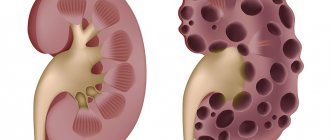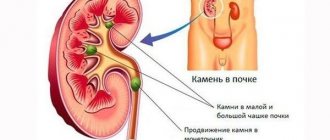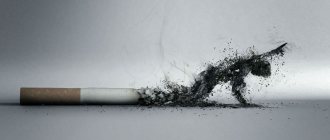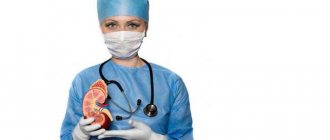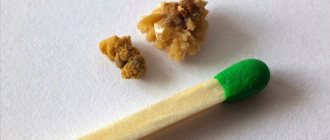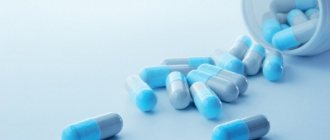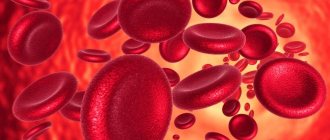The kidneys are part of the body's internal system for eliminating toxins and salts that are formed as a result of metabolism or ingested with water and food. With a large load on the system, the risk of developing kidney stones increases, which significantly reduces the quality of life.
Causes of kidney stones in women and men
At the moment, there is no single reason that would explain the appearance of urolithiasis and kidney stones in particular, but this, as with other diseases, does not exclude the possibility of identifying predisposing factors for the development of this type of pathology.
The main mechanism provoking the development of the disease can be identified as congenital. Its essence lies in the fact that with an initially minor disturbance in metabolic processes, insoluble salts begin to form, and it is they, as is clear, that become the basis for the subsequent formation of stones. The chemical structure of stones may differ, however, if there is a congenital predisposition to the development of urolithiasis and kidney stones, these diseases can develop even in the absence of predisposing factors in the form of specific bases that form stones. We will talk about such basic elements that make up stones in the section on types of stones below.
There are certain metabolic disorders that contribute to the formation of kidney stones (urinary stones), these include the following:
- increased levels of uric acid in the blood - hyperuricemia;
- increased levels of uric acid in the urine – hyperuricuria;
- increased levels of phosphate salts in the urine - hyperphosphaturia;
- increased levels of calcium salts in the urine - hypercalciuria;
- increased levels of oxalate salts in the urine.
The listed shifts in metabolic processes are attributed by many authors to the influence of exogenous factors (i.e., factors acting from the external environment), but the influence of endogenous factors (the internal environment of the body) is not excluded; in frequent cases, both types of factors are interconnected.
Let us highlight the exogenous factors that provoke the development of urolithiasis:
- features of climatic conditions;
- features of drinking and eating regimes;
- soil characteristics (its geological structure);
- features of flora, chemical composition of water;
- features of living conditions (sedentary lifestyle, monotony);
- features of working conditions (for example, work in hot workshops, hazardous production, heavy physical labor).
Let us highlight separately the specified factor regarding food and drinking regimes. In particular, they mean the calorie content of food consumed, excessive amounts in the diet of food saturated with ascorbic and oxalic acids, calcium, salts, and protein. This also includes a deficiency in the body of vitamins A and B.
The endogenous causes of the development of urolithiasis and kidney stones include the following:
- hereditary predisposition;
- hyperactivity of certain enzymes in the body, their deficiency or absence;
- infectious diseases of the urinary tract;
- infectious diseases of a general type (furunculosis, salpingoophoritis, osteomyelitis, tonsillitis, etc.);
- liver diseases, diseases of the biliary tract and gastrointestinal tract;
- suffering from illnesses or severe injuries that cause a long period of immobilization (bed rest, limited mobility).
An undeniable role is played by local changes affecting the urinary tract, which may be associated with actual developmental anomalies and other features that impair their functionality.
General recommendations
There are many types of kidney cleansing using folk remedies at home. Do not rush to use the first recipe you come across at your own peril and risk. Remember, at your discretion, you have the opportunity to clean only small stones. The best option would be a competent consultation with a nephrologist and the choice of a cleansing technique.
Created folk recipes for home cleansing are based on the medicinal properties of plants. With their help, sand and stones are removed from the body, and the function of the renal system and bladder is restored.
Preparation
Before carrying out the procedure, you must undergo the necessary preparations for cleaning.
Note:
- It is advisable to completely switch to dietary nutrition and get rid of sweets, flour, nuts and dried fruits.
- It is important to eat plenty of raw vegetables and fruits.
- Freshly squeezed juices and fresh juices, infusions of diuretic herbs will be the best drinking option. It is also recommended to use clean spring water.
- It is also better to exclude protein from the diet for a while.
- It will be useful to add “warming” spices to dishes - onions, garlic, ginger, cloves, pepper.
- Be sure to take hot baths (every day) with horsetail decoction.
- During preparation, you need to increase your physical activity - move around a lot, run, dance, do physical exercises.
The most important thing before the procedure is to consult a doctor and undergo an ultrasound scan in order to exclude the presence of an inflammatory process in the kidneys and urinary system.
When is the best time to carry out
You can cleanse your kidneys at home at any time of the year.
Experts agree that the best period for cleansing may be early spring (the time of Lent) or autumn, when you need to prepare the body for winter.
Diet
To maintain health, the proper functioning of all organs and systems is important. There is a certain set of products that can both improve the quality of the renal system and, conversely, slow down its productivity.
Healthy foods:
- cranberries - protect against infection and inflammation;
- apples, bananas, plums - eliminate toxins;
- bran - improves blood circulation;
- rose hips - tones and replenishes the body’s defense function against viruses;
- sea buckthorn - restores the contractile functions of the urinary system.
- pumpkin seeds - remove excess accumulated liquid;
- fatty fish - contains fats important for the body;
- herbal teas - cleanse from sand and salts;
- pure spring water - regulates the process of formation and removal of urine, and with it - harmful substances;
- Coffee containing caffeine in limited quantities does not harm, but improves the functions of the excretory organs: it cleans and, according to experts, several times reduces the occurrence of tumors in the bladder.
The bladder and kidney systems must continually communicate with each other. It is important to pay attention to natural biorhythms - try not to confuse day and night, since the requirements of proper nutrition correspond to this regime. Heavy fatty foods should be consumed in the first half of the day, and simpler foods in the evening.
Prohibited products:
- alcohol, carbonated drinks, coffee have a detrimental effect on healthy cells;
- pickles, marinades, smoked meats, fast food - cause swelling due to the high salt content;
- pork, beef, offal - an excess of iron contained in these products has a very negative effect on the function of the excretory organs;
- vinegar and hot seasonings in foods increase the amount of waste, irritating the ducts;
- early vegetables, fruits and greens - oversaturation with chemical additives contained in these products does not have the best effect on the organs, the poison accumulates and is very difficult to remove;
- mushrooms, legumes - recommended to be consumed only in small quantities;
- antibiotics, analgin and similar drugs are used with great caution.
There is a huge amount of harmful and low-quality food in our world. For the benefit of the body, it is better to refuse them and use only healthy and high-quality food.
Mechanism of stone formation
The mechanism of the initiation and development of nephrolithiasis depends on various factors (urine pH, type of diathesis, excretion of one or another type of salt, etc.). According to experts, the primary formation of stones occurs in the renal pelvis and collecting ducts. First, a core forms, and then crystals begin to form around it.
There are several theories of stone formation (crystallization, colloid and bacterial). Some authors note that the main role in the process of nucleation is played by atypical gram-negative bacteria capable of producing apatite (calcium carbonate). These microorganisms are detected in 97% of all kidney stones.
Most often, nephrolithiasis is diagnosed in males. At the same time, women are characterized by more severe forms of pathology (for example, coral stones, which occupy almost the entire cavity system of the excretory organ).
Due to the fact that kidney stones are a polyetiological disease, before developing treatment tactics, it is necessary to try to find out the cause of the development of the pathological process.
What to do when a kidney stone passes
The first sign that a stone is coming from the kidney is pain when urinating. You should not panic, but consult a doctor. In the absence of a doctor, first aid is as follows:
- Take any antispasmodic (“No-shpa”, “Papaverine”).
- Drink or inject an anesthetic (Ketanov, Baralgin).
- Sit in a hot bath, drink plenty of water or any diuretic while sitting in it.
- After 20 minutes, leave the bathroom. Perform active actions (squat, run up the stairs) so that the stone finds a way out.
- While urinating, watch when the pebble falls out.
- To make sure that the stone has passed, go for an ultrasound so that the photo shows the absence of formations in the kidneys.
Types and classification
There are several types of stone formation, differing in their composition and size, namely:
- Oxalates are stones consisting of black-gray salts that have a spiky surface and a dense structure. They are formed due to the high concentration of uric acid;
- phosphates. These smooth, whitish-gray stones form as a result of infections in the genitourinary system;
- urates - light yellow, smooth salt crystals formed from uric acid salts;
- carbonates - smooth, light-colored stones that appear when calcium settles in the urine;
- cystines are yellowish-white, smooth stones formed due to the deposition of cystine. They have a hereditary component;
- protein stones are flat, soft white stone formations that contain infectious microorganisms;
- cholesterol - soft, black stones formed by cholesterol;
- xanthine stones are stones that fall out with apatite in acidic urine.
In addition, stones of not only homogeneous, but also mixed types can form in the kidneys. One of the most complex variants of this disease are coral kidney stones growing in the pelvis. They have a bizarre shape with branched processes.
Drug treatment
In cases where the size of kidney stones exceeds 5 mm, the attending physician may prescribe the following pharmacological agents:
- Urolesan, which loosens stones. Thanks to herbal components, these tablets also have a diuretic effect;
- Spill, which, in addition to softening stones, prevents the possibility of infectious infection and helps strengthen the immune system;
- Phytolysin. This paste, which dissolves in ordinary water, has a very effective anti-inflammatory and diuretic effect;
- Phytolith. This remedy normalizes the balance of minerals in the body;
- Canephron, which prevents the formation of various inflammatory reactions. Available in the form of tablets and drops;
The medications described above are the most prescribed for the breakdown and removal of stones from the patient’s genitourinary system. However, we should not forget that self-medication can significantly worsen the situation and cause various complications for the patient’s body. All medications, as well as their dosage and duration of use, are prescribed exclusively by the attending physician and individually for each situation.
As a preventative measure for urolithiasis or as an addition to drug treatment, doctors quite often prescribe herbal teas that have a diuretic effect and return the balance of minerals in the patient’s body to normal. Such collections should not be treated as alternative therapies, since they are all certified by the Ministry of Health.
Symptoms
Urolithiasis (UCD) goes through three stages of development:
- Hidden, without obvious signs of pathology. Possible: mild chills, increased fatigue, weakness.
- Initial, when the calculus is already formed and, when moving, causes dull pain, often in the lumbar region.
- Severe, with severe attacks and high fever. The stage at which, as a rule, one seeks advice and medical help from a urologist.
Kidney stones do not reveal anything until the crystals begin to “travel” through the urinary system. The main signs of kidney stones are the following symptoms in women and men:
- Severe, paroxysmal, cutting pain in the lumbar region and groin. In men - in the perineum and scrotum. Colic recurs if the urinary tract contains large crystals instead of sand.
- Turbid urine mixed with blood as a result of injury to the urinary tract mucosa.
- Autonomic disorders: pallor, sweating.
Impaired urine passage often triggers an infectious process in the kidneys. Stones always become provocateurs of chronic bacterial inflammation. In such cases, pain is supplemented by general infectious symptoms: headache, weakness, chills. In men and women, the clinical picture of the disease is not fundamentally different.
Causes and symptoms of diseases
The kidneys work as a filter, removing toxins and harmful substances from the urine. But this does not always happen; remaining in the renal ducts and pelvis, these substances eventually turn into sand and stones.
Freeing the kidneys from stones often requires surgical intervention, so you should worry about it in advance and carry out procedures for the proper functioning of this organ.
Symptoms of problems arising in the kidneys:
bags, swelling under the eyes; pain when urinating, frequent or infrequent urination; pain in the groin, lower abdomen, lower back; joint pain; urine with mucus, blood, cloudy; weakness, sweating; vision problems.
The causes of kidney problems largely depend on lifestyle:
water; low quality products; poor nutrition; alcohol, especially beer; smoking; stress; medications.
Timely cleansing of the kidneys helps this organ remove unnecessary fluid and mucus, improves balance, and removes sand and stones that have appeared. However, before you start cleansing, you should definitely be examined at a medical facility and undergo an ultrasound of the kidneys. If the size of the stones is 1 mm or more, in this case you need to refuse cleansing, otherwise the ducts will become clogged, after which surgery cannot be avoided.
You should cleanse your kidneys 2 times a year for 2-4 weeks. The best option would be to get into the habit of performing these procedures without waiting for the stones to appear.
Cleansing the kidneys may be accompanied by pain during urination and aching pain in the lumbar region. So the kidneys begin to actively perform their functions, removing toxins and sand. You can soothe such pain by taking a bath.
Return to contents
Diagnostics
There are a number of diagnostic methods with the help of which diseases of the urinary system are detected by specialists in the early stages. But the awareness of patients is also important here. Every person, when the first symptoms of pathologies of the genitourinary system appear, should consult a doctor, since he himself will not be able to understand whether he has stones in his kidneys, ureter or bladder.
After interviewing the patient, the urologist prescribes the necessary examination. First of all, a laboratory urine test is performed to determine the presence of microbial infection, the presence of blood in the urine, and also find out about the nature of salt impurities. Using a general blood test, inflammatory processes are detected. In addition, a biochemical blood test is performed. One of the most important tests for suspected kidney stones is a kidney ultrasound. However, in some cases, ultrasound still does not make it possible to determine the presence of stones in the ureter, since they may be located deep behind the peritoneum.
In order to detect stones, the patient is often prescribed excretory urography. To do this, a contrast agent is injected into a vein, after which X-rays are taken. Studying a general image of the urinary system allows the doctor to identify exactly where the stones are located and find out what their shape and size are. But at the same time, the specialist takes into account that some stones are capable of transmitting X-rays. As a result, they are not visible in the photographs.
Another research method is radioisotope nephroscintigraphy. The procedure begins with the injection of a special radiopharmaceutical into a vein. It accumulates in the kidneys and is then excreted through them. At this time, the kidneys are scanned, which makes it possible to determine whether their functions are impaired. The study is informative for a specialist.
Fighting methods
How to remove sand from the kidneys using folk remedies
If we talk about how the disease manifests itself, the symptoms appear after the stone begins to move. Sharp protrusions on stones irritate the mucous membrane and lead to an inflammatory process. The attack may be preceded by the following symptoms: pain and heaviness in the lower back, legs, and the appearance of lameness. The patient has a characteristic posture, he pulls his legs towards his stomach, because when straightening the lower extremities, the painful sensations intensify. A person experiences a frequent urge to urinate and a feeling of an incompletely emptied bladder.
Treatment should begin with a diagnostic examination, which includes the following: general blood and urine tests, ultrasound, radiography, urography. You should not self-medicate, since stones can only be removed if you know their chemical composition and location.
How to treat and get rid of kidney stones?
It is believed that the pain associated with renal colic is the most severe of all possible, so pain control is the main task in relieving this complication of urolithiasis.
For renal colic, the best combination of effectiveness and safety is demonstrated by nonsteroidal anti-inflammatory drugs (NSAIDs) - Diclofenac, Ketorol, Indomethacin, Ibuprofen, etc., which are prescribed for a period of 3 to 7 days (see list of injections for pain). Narcotic analgesics do not have any advantages over NSAIDs and are prescribed when the use of Diclofenac and its “relatives” is impossible, for example, due to allergies.
As an addition to NSAIDs, antispasmodics can be used: papaverine, no-spa, etc.
If the kidney block cannot be eliminated with medication, surgical decompression of the urinary tract is performed, which can be of two types:
- Retrograde stenting. Using special equipment, a special catheter, a stent, is inserted through the ureter into the kidney. This stent is located at one end in the renal pelvis, and the other is lowered into the bladder, ensuring the outflow of urine.
- Percutaneous nephrostomy. Under ultrasound guidance, a puncture of the renal pelvis is performed through the skin of the back. A catheter is inserted into the pelvis through a puncture, draining urine out of it.
Percutaneous nephrostomy is much more traumatic, but much simpler, so stenting has not yet replaced it. Decompression is considered a temporary measure, followed by surgical removal of the stone.
Lithokinetic therapy
This is the expulsion of a kidney stone using medications. When to start treatment for urolithiasis is not an idle question. It is believed that urinary stones up to 6 mm, which do not give obvious symptoms, do not grow and do not cause complications, do not require treatment. Expulsion of such a calculus is a “double-edged sword.” You can remove it, or you can get even more sick. This stone will plug the kidney tightly and a small problem will grow into a huge one...
Lithokinetic therapy is considered justified if it is necessary to remove stone fragments from the kidney after its destruction by surgical methods.
Dissolving stones
Drug dissolution of uroliths in the kidneys, or chemolysis, is used to treat urate stones. To do this, you need to make your urine slightly alkaline. Using special citrate mixtures or sodium bicarbonate (soda), the urine pH is raised to 7.0 or higher, and maintained at this level for several weeks. The dose of the drug, including soda, is selected individually, and the effectiveness of treatment is monitored using special test strips.
External shock wave lithotripsy (ESWL)
The essence of the method is the non-contact destruction of stone by the force of an ultrasonic wave. It is considered the most effective and safe method of getting rid of stones; it allows you to eliminate uroliths up to 20 mm in size in 90% of cases.
Contraindications for ESWL
- Pregnancy
- Reduced blood clotting
- Active urinary tract infection
- Severe obesity
- Signs of urinary tract obstruction below the cleavage zone
Some features of the procedure:
- The ultrasonic wave affects not only the calculus, but also the skin, which can cause pain, sometimes quite severe, so ESWL requires adequate pain relief.
- During ESWL, the stone is broken into small fragments, which can cause renal colic.
- It is not always possible to destroy urolith from the first session; some patients may require 2 or more procedures.
Surgical Treatment Options
The choice of surgical treatment method for urolithiasis depends on the size and position of the stone, the condition of the urinary tract, the activity of the infection, the patient’s build, the doctor’s experience and many other factors.
- Endourethral technique - endoscopic equipment is inserted into the renal pelvis through the urethra or through a puncture in the skin. The device is brought to the stone, which is removed or destroyed in one of the following ways: mechanically, with a contact ultrasonic wave, or with a laser beam.
- Open surgery is the oldest, most reliable, but at the same time the most traumatic and therefore dangerous method. The stone is mechanically removed through an incision in the kidney or bladder. Used when it is impossible to use ESWL or endoscopic techniques: severe obesity, severe skeletal deformities, staghorn stone, etc.
Cleansing methods
Sand and stones deposited in the kidneys are extremely rarely removed from the body easily and without additional help.
There are two types of stones:
- Urate type of stones - destroyed with a change in the acidity of urine, this is facilitated by cleansing the kidneys.
- The oxalate type is less susceptible to this effect, and medications help in preventing and slowing down the growth of accumulated waste. This action is applicable to the fight against stones whose size does not reach more than 4 mm, otherwise serious complications may arise.
Cleansing occurs with the help of medications and home methods.
The medicinal method includes:
- diuretics (furosemide/lasix, indapamide, hypothiazide, veroshpiron) - resume active filtration of the renal system;
- medicines for dissolving stones (phytolysin) - act on small types of stones, the benefits of use will be almost invisible.
Clearing kidney stones with medications is an ineffective task. Carrying out prevention with the help of diuretics is too thoughtless and is fraught with consequences for one’s own health.
Home methods consist of using:
- berries, herbs, fruits and vegetables;
- juices;
- cereals;
- herbal preparations;
- hot baths.
This option for getting rid of the disease is the simplest and most gentle for the body.
Purpose of the event
All excess fluid is easily removed from the body through proper cleansing. The heart begins to pump blood more actively. Metabolism, blood and intraocular pressure are normalized.
Gradually the problematic kilograms go away. The joints become more flexible and movements become easier. The functioning of the renal system returns to normal, swelling and bags under the eyes disappear, and a healthy appearance appears.
Mineral waters that dissolve kidney stones
Drinking mineral water helps dissolve kidney stones. However, you need to choose it correctly.
- Alkaline mineral water is suitable for treating patients with urate and oxalate stones. These are drinks such as: Borjomi, Dilijan, Essentuki 17, Polyana Kvasova.
- Acidic mineral water effectively removes phosphate stones from the body. These are drinks such as: Narzan, Mirgorodskaya, Smirnovskaya.
A mineral water bottle may have a number on it. If the number is 17, then the water is alkaline. If the name is followed by the number 4, then such water is slightly alkaline. It is worth considering that mineral waters with the same name may have different alkalinity and acidity. It is to determine this indicator that water is numbered.
Tips and tricks
Prevention of the formation of kidney stones lies primarily in a healthy lifestyle and proper nutrition.
Necessarily:
- Stimulate blood circulation, avoid blood stagnation.
- It is recommended to drink as much environmentally friendly (artesian) water as possible - at least 2 liters per day (especially in summer). It removes sand and small stones well.
- The diet should contain less meat dishes and more vegetables and fruits. Don't forget about greens and grains.
- You should also regularly (at least 2 times a year) undergo an ultrasound scan for the purpose of prevention and timely treatment of various diseases of the kidneys and bladder.
- People prone to stone formation are advised to undergo sanatorium-resort treatment.
Yoga asanas are perfect for preventing kidney disease:
- bhujangasana - helps to avoid the occurrence of stones;
- salabhasana - for organ rejuvenation;
- mayurasana - helps flush the kidneys.
Experts recommend constantly maintaining an active lifestyle, including moderate physical activity. Active rest will give energy and restore blood circulation, thereby preventing the deposition of harmful substances.
Folk remedies
At home, in addition to medications, you can use herbal infusions and decoctions. Folk remedies for kidney stones are often used in therapy together with medications. It is better to first coordinate your appointment with your doctor.
You can use the following recipes:
- For urates and oxalates, you can make the following infusion. Take 200 ml of olive oil, vodka, honey, lemon juice and mix everything thoroughly. Place the mixture in a cool, dark place for 2 weeks and close the container tightly. You need to drink it 1 tbsp. l. per day for 2 weeks, then you need a break of 5 days and repeat the course again.
- Rosehip root is well suited for remote crushing. You need to take 35 g of dry, crushed raw materials, pour 2 cups of boiling water and leave in a water bath for 15 minutes. Remove from the stove and wrap the product for 6 hours. Then the broth must be filtered and taken half a s. 4 times a day 30 minutes before meals. The effect of this remedy is strong, so it should not be taken for more than 4 weeks. Before use, you should consult your doctor or herbalist.
- You can prepare a decoction of watermelon rinds. You can take as raw materials only berries that have grown on your home plot; cultivated varieties are grown with a large amount of nitrates, and this is harmful for this disease. Watermelon rinds need to be dried in an electric dryer or oven; it is better to cut them into pieces. Then you need to fill them with water and boil over low heat for about an hour. Filter the broth and take 1 glass 3-5 times a day before meals.
- Take 10 lemons and pass them through a meat grinder, first separate the seeds and peel. Place the resulting mass in a 3-liter jar, add 2 tbsp. l. medical glycerin and pour 2 liters of boiled water. Let the date stand for half an hour and strain. You need to drink the entire bottle within 2 hours with an interval of 10 minutes between servings. Next, place a warm heating pad on the sore kidney; you will feel increased pain (sand will begin to come out). For each preparation, you need to prepare fresh lemon juice, because it quickly loses its properties.
Kidney cleansing with watermelon
- This option can be used only once a year - during the ripening season of these fruits. August-September is the optimal time. It is recommended to eat only watermelons and rye bread for a week.
- At this time, the urine may become cloudy, and the person will feel slightly tired. Such phenomena indicate the removal of sand. It is allowed to extend the diet for another week if cleansing is very slow.
- To take advantage of the diuretic effect of watermelon, you can dry its rinds. They are thoroughly washed, crushed and dried in the oven. It makes a wonderful diuretic tea, which is drunk in winter and spring, when fresh watermelons are not available. The effect of such a drink is no worse than the fruit itself.
Nutrition and diet
Curing a disease is not only about removing the stone; it is important to prevent its reoccurrence. Diet is the main point of complex treatment. The list of permitted products depends on the composition of the stone:
- With urates, the amount of meat, chocolate, salt, coffee, and legumes decreases. The emphasis is on dairy and plant products.
- If you have oxolates, limit the consumption of foods with ascorbic acid (sorrel, spinach), coffee, sweets, and dairy products. The emphasis is on meat and plant foods.
- With phosphates, dairy and vegetable products and spices are excluded. The diet includes meat and flour products.
- The main condition is to drink at least 3 liters of clean, filtered water per day.
Diet
When cleansing the kidneys, you should follow a certain diet. Prohibited foods include chocolate and coffee, alcoholic beverages, hot herbs and spices, smoked, canned and salted foods, cheese, fatty meat and fish, as well as strong broths (except vegetable ones).
It is recommended to consume more:
- Flour products – white/gray/bran bread, unsalted cookies;
- First courses - fruit, vegetable, milk soups, vegetarian borscht, pasta and cereal soups;
- Second courses - boiled lean meat, the same fish, steamed cutlets, boiled or stewed vegetables, pasta, cereals, eggs (no more than 2 pieces per day);
- Sweet drinks and desserts - rosehip decoction, dried fruit drinks, tea (weak) with and without milk, fruit and berry juices, jellies and jelly. In August-September, eat more watermelon and melon;
- Dairy and fermented milk products – kefir, yogurt, sour cream, cottage cheese, cream;
- Fats – butter (unsalted), vegetable;
- Sauces – vegetarian or dairy/sour cream.
Complications
KSD is fraught with kidney loss or even death. More common:
- Nephrosclerosis, in which healthy tissue is replaced by scar connective tissue.
- Pyelonephritis (acute or chronic). An infectious disease with nagging pain in the lower back and abdomen.
- Pyonephrosis is a pathology in which the kidney turns into a “bubble” with pus. The affected organ is removed to stop further spread of the infection.
- Kidney failure. The level of nitrogen-containing compounds in the plasma increases, including uric acid and creatinine. Toxic substances poison the body, which can lead to the death of the patient.
- Acute cystitis with injury to the bladder mucosa. It causes inflammation, especially during hypothermia due to easier access to various infectious agents against a background of weakened immunity.
- Urethritis, in which the damaged mucous membrane of the urethra becomes an entrance for pathogenic bacteria.
Among the common complications of ICD:
- Anemia with weakness, tachycardia, dizziness.
- High blood pressure associated with overproduction of the hormone renin.
- Salt deposits in various organs.
Prevention and prognosis
In most cases, the prognosis for treatment and further recovery is favorable. The disease may not recur if all specialist recommendations are followed. Otherwise, kidney stone disease can lead to the formation of calculous pyelonephritis, symptomatic hypertension, chronic renal failure and hydropyonephrosis. When stones are passed in the urine, they must be sent for laboratory tests, where the composition will be determined. This allows you to prescribe the correct dietary course of treatment, which will help avoid the formation of new stones.
In addition to diets, experts recommend that their patients follow the following rules:
- adhere to the regime of drinking a large volume of water so that about three liters of urine are excreted per day;
- if you are overweight, try to get rid of it;
- pay attention to the regularity of bowel movements;
- Do not use diuretics without doctor's advice. This can lead to dehydration;
- constantly move, lead a healthy lifestyle;
- try to spend less time on long trips by transport;
- if your work activity takes place at the computer, then you need to take breaks more often, getting up and warming up;
- carefully monitor the level of acid and alkali in the urine using litmus paper;
- consume foods containing vitamin C in moderation;
- do not abuse alcoholic beverages;
- do not drink chilled beer or kvass. These drinks affect the smooth functioning of the kidneys;
- do not swim in cold water;
- avoid drafts;
- reduce portions of foods containing proteins, since protein in the body increases acidity. It resists the absorption of calcium, which leads to the precipitation of calcium salts.
Considering that the symptoms of kidney stones are very similar to various types of diseases, the patient is recommended to seek help from a doctor at the first sign. If kidney stones are removed, the patient must strictly follow the prescribed diet and eliminate associated risk factors.
Drug dissolution of stones
The basis of medications that are designed to dissolve kidney stones are mostly combinations of medicinal plants. The drugs should be taken for a long time, since the dissolution of stones occurs slowly. It should be remembered that the best results during therapeutic measures can be achieved only by combining medication with diet and maintaining an adequate drinking regime.
Table: medications that help dissolve kidney stones
| Name of the drug | Compound | Release form | What stones does it work on? | Operating principle |
| Blémarin |
|
|
|
|
| Allopurinol | Allopurinol | Pills | Urats |
|
| Canephron |
|
|
|
|
| Phytolysin |
| Paste | Mixed types of stones |
|
| Asparkam |
| Pills | Oxalates |
|
| Marelin |
| Pills | Phosphates and oxalates |
|
| Spilled | dietary supplement | Pills and capsules | Oxalates |
|
| Urolesan |
|
| Mixed stones |
|
| Cyston |
|
| All types of stones |
|
Since the age of seven, I have had urolithiasis and have been treated with DLT three times. She hadn’t been checked for three years, she went to the hospital with an attack, they did an excretion, the whole kidney was covered in small stones (the doctor said it couldn’t be crushed). The doctor prescribed Blemaren, took it by the hour, and filled out a table using test strips 3 times a day. After drinking 2 packs, we did an ultrasound; there were still stones, but not so many. I'll be drinking more in a month. I want to say that sometimes when I drank, there were pains and stings, I took painkillers. And my hair has deteriorated very much, it is falling out a lot, it seems to me that this is a side effect. But hair, I think, is not so scary compared to the pain I experienced when the stone hit. I will take more, I hope to drive it out before the end.
Valeria V.
https://protabletky.ru/blemaren/
Photo gallery: means for medicinal dissolution of kidney stones
Blemaren in the package contains diagnostic test strips that allow you to independently monitor the acidity of urine; doctors consider this drug to be the No. 1 drug in dissolving urates
Canephron is available both in liquid form and in tablets, approved for use during pregnancy
Cyston is a medicinal preparation based on a large number of medicinal herbs that prevents the crystallization of salts and the formation of new stones
Asparkam contains potassium, which can replace calcium salts in oxalate stones; potassium salts then easily dissolve and are excreted from the body along with urine
Dissolving kidney stones with herbs
Herbal medicine in dissolving kidney stones should be used with caution. Medicinal herbal infusions indicated for kidney diseases have a weak antiseptic, anti-inflammatory and diuretic effect, and they can only be used if there is instrumentally confirmed presence of small stones (3-4 mm in size) that are able to freely exit the body. If the stones are larger in size, there is a danger that, under the influence of the renal collection, the urodynamics will change, the stone will move out of place and lead to blockage of the ureter. If small stones are found in the kidneys, it is recommended to use decoctions of the following herbs:
- rosehip root decoction - you need to pour two tablespoons of dried crushed rosehip root into a glass of water, boil and cook for 15 minutes, then remove from heat and leave for an hour (the decoction should darken); take one third of a glass of the resulting decoction three times a day before meals;
- decoction of the herb pol-pal (woolly erva) - 2 tablespoons of the herb, which can be purchased at the pharmacy, pour a glass of boiling water and leave in a water bath for a quarter of an hour, after which it is kept for 60 minutes at room temperature (you can use a thermos into which you pour grass, pour boiling water and leave for one hour); apply a quarter or half a glass three times a day before meals;
- in a similar way, you can prepare and use decoctions of knotweed, bearberry, lingonberry leaves - they all have anti-inflammatory and weak diuretic effects, the therapeutic effect is manifested specifically in renal pathology, decoctions of these herbs help remove “sand” from the kidneys and prevent further stone formation.
Video: preventing the formation of kidney stones using herbs
From my own experience, I have not had the opportunity to experience the effect of traditional methods in the treatment and prevention of urolithiasis, however, people who are familiar with this diagnosis first-hand have more than once mentioned the good therapeutic effect of taking ordinary baking soda. It helps only in the presence of urate stones, since it promotes alkalinization of urine. Daily intake of one teaspoon of soda dissolved in half a glass of warm water helped normalize the condition and prevented the formation of new stones. In this case, you should pay attention to the need for long-term, at least two months, use of this drug.
